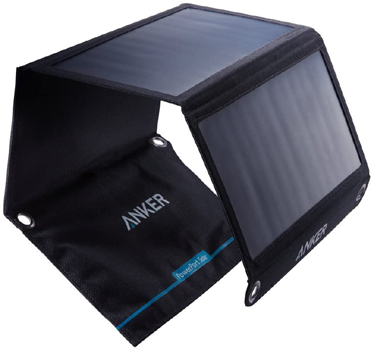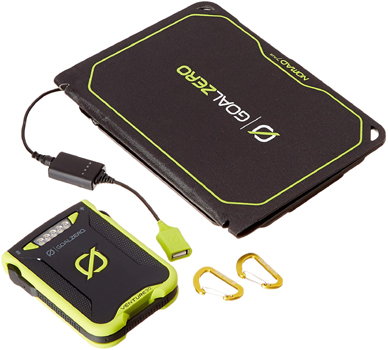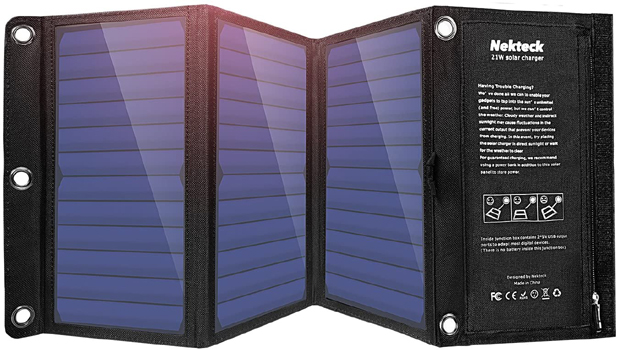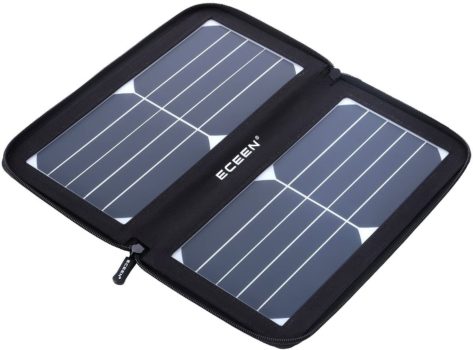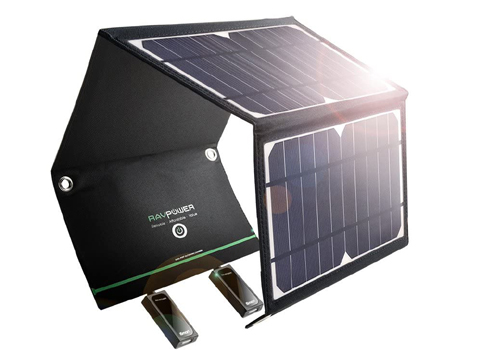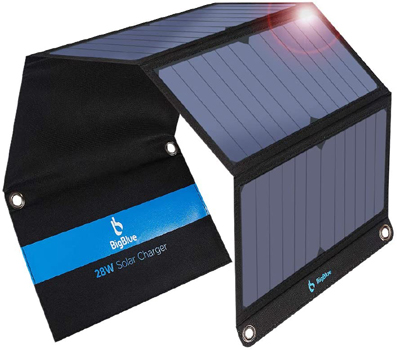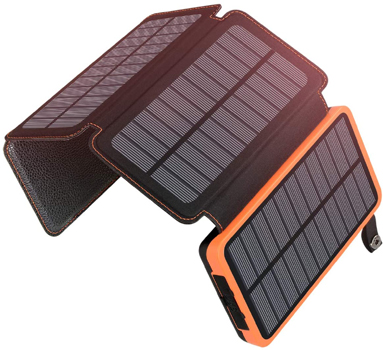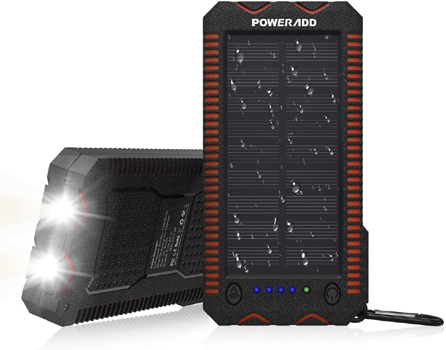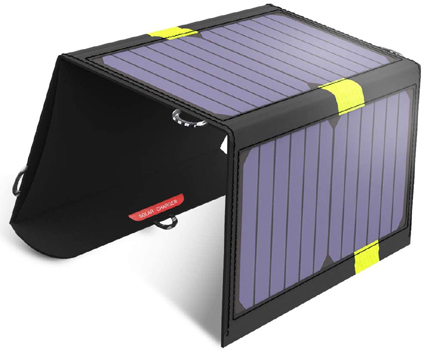There’s a growing use of small electronic appliances in the outdoors, which creates the need for portable power solutions for recharging the devices. Investing in the best solar charger for backpacking is a great way to stay connected while taking off-the-grid trips. A solar charger is a gadget that will harness the sun’s power and use it for recharging personal electronic devices on the go. Portable solar panels are becoming a popular way to ensure you travel with a backpack with charger for multipurpose outdoor usage.
Bringing some additional pairs of AA or AAA batteries for your weekend trips won’t do the trick. While having an extra portable battery is a noble idea for outdoor hiking and travels, your electronics usage is likely to exceed the backup power storage. You need a reliable supplemental energy source that will sustain your electronics’ power needs. For that reason, solar energy is the most suitable choice for making long trips that will require multiple devices recharges.
The majority of electronics depend on rechargeable lithium-ion batteries. Therefore, you must have a backpack with charger that will keep your gadgets running during the trip. Fortunately, you can get one of the reliable, lightweight solar chargers to recharge your small appliances like smartphones. One of our objectives is to assist you in gearing up for the outdoors. In this post, we’ll take you through the factors to consider when purchasing the best solar charger for backpacking. After that, we will give you a selection of the best portable solar charger options for a backpacker.
The Best Solar Charger For Backpacking: Everything You Should Know
We often think of getting a battery pack as essential hiking gear. The portable power bank can store charge for use to recharge your devices. But it will also need recharging. You can compare a portable battery’s storage capacity with the battery in your electronics to get an idea of the number of available recharges.
Also, note that energy transfer between two batteries is never 100 percent efficient. A 2,000 mAh power pack, for example, cannot fully recharge your phone’s 1,000 mAh battery twice. And that’s where the best solar charger for backpacking comes in handy. With an efficient travel solar charger, you can recharge all your electronics when you’re away from a wall outlet. It is an invaluable gadget for a backpacker, especially when you have several electronic devices like a smartphone, flashlight, GPS, and camera, among others.
The best solar charger for backpacking offers an unmatched portable power technology because it comes as a natural solution that harnesses the power of the sun. However, solar panels may not be the perfect solution for all off-the-grid travels. You’ll want to get it for traveling in places where you can depend on a few hours of daily sunshine. It’s advisable to take an extra portable battery with you if you’re vising areas with unreliable sunlight. In the next section, we’ll help you understand how a solar battery charger functions, and why the sun is important.
How Solar Battery Chargers Work
A solar battery charger is an appliance that taps and transforms the sun’s power into electricity. The electricity then charges electrical devices like a cellphone, car battery, fan, and laptop, among others. Note that the best solar charger for backpacking doesn’t directly charge your cellphone or iPad’s lithium-ion battery.
Solar battery charges work by charging an internal rechargeable battery using the solar modules. The latter then redistributes the energy to your drained gadget without the need for an external electrical source.
Before we get far, you should keep in mind that solar power isn’t the ultimate cure for replacing spent energy in your gadgets. You can’t recharge the battery for a boat, electric scooter, or RV, for example, and complete in a few hours. Assume you’re charging a discharged 100-amp hour battery using a 30-watts solar panel. The battery will be fully-charged in nearly a week, under the ideal summer sunshine.
Moreover, you should know that you can only achieve the maximum solar panel’s power ratings with direct sunshine on its surface. Some conditions, like shadows, equatorial direction, overcast sky, short winter days, or improper mounting angle, will reduce the output of a solar battery charger.
Now, backpacking solar chargers can’t expel electrical energy directly into your devices. Instead, they have a built-in battery pack. In this way, the integrated battery stores the electricity that solar cells generate, making it available for recharging your gadgets with charging supercapacitor afterward.
The charging supercapacitor is the most critical part of the solar charger. It enables the best solar charger for backpacking to charge electrical appliances on demand, even in the absence of direct sunlight.
A Step-By-Step Guide on How The Solar Charger Works
An ordinary power bank functions similarly to the photovoltaic system of a solar panel charger, as follows:
- The sun’s rays strike the solar charger’s surface
- Solar cells making up the whole solar charger’s surface then absorb the light energy
- Photons in the sun’s rays activate the electrons within the silicon-made solar panel, resulting in an electric field
- The electric field is a force that moves to the battery charger kit of your solar system
- Your solar charger battery stores the electricity for later charging of a compatible device
- The best solar charger for backpacking has a built-in charge inverter that converts the stored energy into a usable form, usually from direct current to alternative current
- Some electrical appliances use DC electricity for charging batteries, while others use AC power. It means some gadgets may not require an integrated charge inverter.
- The last step involves the expelling of electricity from the solar battery charger to your device.
While the above process may seem complicated, you only need clear sunlight for the best solar charger for backpacking to work.
Advantages of Using Solar Charger for Backpacking
Backpackers and hikers don’t love the best backpacking solar battery chargers for no reason. Portable solar chargers are convenient, easy-to-use, and have numerous benefits. Here are some of the advantages that come with the best solar charger for backpacking.
- The best portable solar battery chargers can work while storing energy concurrently in the sun. You can then use the stored electricity to charge your appliances efficiently without the sun.
- Overexposure to sunlight can affect some devices like smartphones. You can use a travel solar panel to charge your cellphone in the absence of the sun.
- You can use a portable solar battery charger anywhere and anytime since they don’t depend on an electrical source to function.
- Solar energy is a free, renewable power source that you can use without expecting any bills.
- Solar chargers are dependable. The best solar charger for backpacking will not wear out quickly. It means you’ll keep benefiting from their consistent and efficient functions for a long time, making them a reliable energy source.
- Solar panels are a green energy source that won’t produce toxic gases to pollute the environment.
- Portability is probably the most significant benefit of a travel solar battery charger. The units are compact, lightweight, and easy to transport anywhere.
Now that you’ve seen the benefits of investing in the best solar charger for backpacking let’s see the practical situations where these portable supplemental power kits are applicable.
Practical Considerations For A Portable Solar Battery Charger
Before you get the best solar charger for backpacking, take time to read these practical best-case-scenarios for their usage.
- Mode of Travel: A solar charger needs long exposure times to direct sunlight to be effective. For that reason, activities like sea kayaking and biking are suitable for on-the-go battery charging with a portable solar panel. Also, open-country backpacking can be appropriate if you’re able to position your panel towards direct sunlight. But you won’t benefit from strapping your solar panel to your backpack’s top when hiking under a thick forest canopy.
- Type of Battery: It’s advisable to get a solar charger that can power up a set of spare batteries if your electrical gadgets are only compatible with AA batteries. In this way, you can alternate two battery sets instead of bringing multiple spares.
- Weight and Size: Note that all solar chargers add weight and consume space. You should determine if a solar charger’s unlimited power is an absolute necessity or if one emergency power boost might be sufficient. The larger and bulkier a solar-powered battery pack, the higher storage capacity it will have to offer multiple.
It’s always best to avoid draining your device battery completely before a recharge for the best results. Moreover, power packs only supplement energy and are not a guarantee. Therefore, don’t assume that these gadgets will offer a full charge for your device’s rechargeable battery.
10 Best Solar Charger for Backpacking
The best solar charger for backpacking comes with different features and functionalities. Here is our top ten device selection with their pros and cons to make it easy for you to choose.
Anker PowerPort Solar Battery Charger
The 21-watt solar charger by Anker is a portable energy source for your off-the-grid travels that can fold into a notebook’s size. It is one of the finest benchmarks of what you should consider in the best solar charger for backpacking. Its thin, flexible design allows it to fit in your backpack or simply hang from it.
Key Features
- Two universal serial bus ports
- 5-volt or 3-Amp power output
- Supports up to 21 watts power
- 2-ounce weight
- Foldable
- Four mounting holes
- It comes with a three-foot micro USB charging cable.
- It provides a quick, powerful charge for your small appliances
- It integrates convenient mounting grommets
- It comes with an 18-month warranty
- The two USB ports are ideal for charging two devices simultaneously
- Lightweight design for portability
- Collapsible model to consume less storage space in your backpack.
- On the pricey side
- No internal battery
7-Watt Goal Zero Venture Solar Charger
The 30 Plus solar recharge kit by Goal Zero Venture is a dynamic portable power source that packs a USB battery. Thanks to its powerful USB charging ports, it will recharge your phones at super-fast speeds. The solar travel charger is an excellent supplemental energy source for emergencies.
Key Features
- Two universal serial bus dongles, including a micro cable
- 5-volt or 4.8-Amp power output
- It comes with a 7,800 – mAh USB battery backup
- Supports up to 7 watts power
- 56-pound weight
- Foldable
- Supports USB wall charging
- It comes with a kickstand.
- It comes with an integrated USB battery
- Unmatched recharge time
- Compact model for use on the go
- It is effortless to set up
- Includes a convenient kickstand for proper sunlight exposure
- Dual-charging system for the internal battery
- Takes up to nine hours to recharge the internal battery
- On the pricey side
21-Watt Nekteck Travel Solar Charger
Nekteck’s portable power technology is a convenient solar battery charger that can handle two devices simultaneously. The foldable device opens up into over two feet long of sunlight exposure surface, giving a powerful charge for your electrical appliances.
Key Features
- Two universal serial bus ports
- 5-volt or 3-Amp power output
- Available in waterproof panels
- It comes with a three-foot micro-USB cable
- Supports up to 21 watts power
- 1-pound weight
- Foldable
- Includes four mounting holes
- Stable dual-USB charging system for your devices
- 18-month factory warranty
- Foldable, easy-to-fit model
- Durable construction
- Easy to use with multiple grommets
- Compact kit for its size
- Quick, powerful recharging
- All-weather design
- It doesn’t have an internal battery.
Eceen Travel Solar Battery Charger
The ECEEN solar panel comes in a foldable design for quick usage on your wild trips. Its nylon-zippered shell makes the lightweight phone charger quite durable.
Key Features
- Two universal serial bus ports
- 5-volt or 1.5-Amp power output
- Available in nylon shell zippers
- It comes with a three-foot micro-USB cable
- Supports up to 10 watts power
- 8-ounce weight
- Foldable
- Includes four mounting carabineers
- Convenient D-ring mountings
- Very lightweight design
- Collapsible, easy-to-fit model
- Durable construction with poly shell zip
- Affordable travel power bank
- Waterproof make
- It doesn’t have an internal battery
- Low power supply for your devices
28-Watt RavPower Travel Solar Battery Charger
The three-port RavPower solar charger is a powerful off-the-grid travel companion for all your small electrical gadgets. Its impressive wattage and unmatched triple power output make it one of the best solar charger for backpacking options on our list. It delivers sufficient energy to charge up your devices on the go.
Key Features
- Three universal serial bus ports
- 5-volt or 4.2-Amp power output
- Supports up to 24 watts power
- Waterproof panels and fabric
- 21-ounce weight
- Foldable
- It comes with four mounting holes.
- Fast, steady charging
- It can charge up to three devices without an internal battery
- Water-resistant construction for extra durability
- Folding design makes it easy to fit in the backpack
- Large mounting D-rings for easy setting up
- Heavier than most devices in its class
- It doesn’t have an internal battery pack.
28-Watt BigBlue Travel Solar Charger
If you are in the market for a large, powerful portable power source, this BigBlue travel solar panel might be your best solar charger for backpacking. The kit will charge up to three devices simultaneously without experiencing a wattage drop-off.
Key Features
- Three universal serial bus ports
- 5-volt or 3.4-Amp power output
- It comes with a three-foot micro-USB cable
- Supports up to 28 watts power
- 21-ounce weight
- Foldable design
- It comes with four mounting holes.
- Free USB charging cable
- Outstanding 28-watt power for quick, powerful device charging
- Stable, multi-device charger
- Includes a 2-year factory warranty
- Collapsible design allows it to fit into your backpack
- Available in convenient mounting grommets
- A large and bulky model
- It doesn’t have an internal battery pack.
5-Watt ADDTOP Travel Solar Charger
The 25,000 mAh portable solar power bank by AddTop is a winner in the smallest, best solar charger for backpacking category. Its compact design can collapse into a smartphone size. The multiple cellphone charges battery can charge from the home’s wall outlet before you hit the road. It is an ideal solution for anyone concerned about affordability and space.
Key Features
- Two universal serial bus ports
- 5-volt or 2.1-Amp power output
- It comes with a 25,000 – mAh USB battery backup
- Supports up to 5 watts power
- 18-pound weight
- Foldable
- Supports USB wall charging
- Two-port charger
- Convenient internal battery for multiple smartphone recharges
- Pocket-size compact design
- Easy-to-use device
- Dual-charging system for the internal battery
- One of the best affordable portable solar chargers
- Low power output
- Long charging time using the solar system
1-Watt PowerAdd Portable Apollo 2 Travel Solar Charger
The Apollo 2 comes as the best solar charger for backpacking with multiple functions. The one-wattage PowerAdd mobile power technology will do just about anything for your outdoor adventures.
Key Features
- Two universal serial bus ports
- Integrated LED flashlight
- 5-volt or 2.4-Amp power output
- An integrated 12,000 – mAh USB battery backup
- Supports up to 1-watt power
- 9-ounce weight
- Comes with USB dongle
- One carabineer
- Built-in electric cigarette lighter
- Supports USB wall charging
- Two-port USB charger
- Convenient built-in battery for sunless charging
- Multi-functional device for emergency survival
- Pocket-size compact design
- Easy-to-use with mounting carabineer
- Dual-charging system for the internal battery
- Lightweight construction
- Includes a two-year factory warranty
- Low power output
- Long charging duration using the solar option
1-Watt PLOCHY Portable Power Bank
The PLOCHY solar charger is another device on our list of the best solar charger for backpacking that primarily serves as a battery backup. Although it’s the size and weight of your cellphone, this kit packs sufficient power to charge your smartphone up to four times.
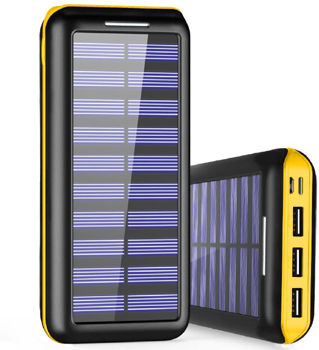
Key Features
- Three universal serial bus ports
- 5-volt or 2.4-Amp power output
- An integrated 24,000 – mAh USB battery backup
- Supports up to 1-watt power
- 34-ounce weight
- Two micro-USB recharge ports
- Comes with a micro-USB charger cable
- A standard USB recharge port
- Supports USB wall charging
- Triple-port USB charger
- Useful built-in battery for emergency device charging
- Cellphone-size compact design
- Dual-charging system for the internal battery
- Smartphone-like weight for portability
- Includes a two-year factory warranty
- Low power output
- Long charging duration using the solar option
20-Watt X-Dragon Travel Solar Battery Charger
The portable X-Dragon solar charger is for anyone who wants a big, powerful travel power backup that easily secures to their backpack. It’s the only machine in our best solar charger for backpacking selection that integrates a surge protector.
Key Features
- Two universal serial bus ports
- Integrated surge protector
- 5-volt or 2-Amp power output
- It comes with a three-foot micro-USB cable
- Supports up to 20 watts power
- One micro-USB charger cable
- 3-pound weight
- One carabineer
- Foldable design
- It comes with four mounting D-rings
- Includes a free USB charging cable
- Built-in surge protector to safeguard your devices
- Strong D-Rings for easy mounting
- Excellent 20-watt power for fast, powerful charging
- Reliable, multi-device charger
- It comes with a carabineer to secure the kit to your backpack
- Rugged construction with nylon cover for added durability
- Low power output in its class
- It lacks an internal battery pack.
The 20-watt X-Dragon mobile power technology sums up the best solar charger for backpacking you can buy right now on the market. Now that you’ve seen our list of top devices, it’s also crucial for you to learn how to pick a suitable solar battery charger for your off-the-grid trips.
What To Consider Before Buying Best Solar Charger For Backpacking
The best solar battery chargers are available in an array of types, price-points, and sizes. Slight variations such as material and panel’s efficiency can have a significant impact, resulting in the pros and cons.
Besides, your terrain, charging requirements, and usage will also determine your decision. We are going to explain the key factors for picking the best solar charger for backpacking in the section below. Note that the portable solar battery chargers on our list are only for small electrical devices.
12 Considerations For Solar Chargers
Consider the following factors when choosing a battery-powered solar charger for your outdoor adventures.
1. Power
Solar chargers come with various specs on volts, watts, and amps. It’s vital to know what these terms mean for you to understand what you are buying. Wattage or watts stand for the output power capacity of a solar panel. At the same time, amps or amperage is a measure of the time an integrated solar battery can supply the specified current. The volts or voltage gives the amount of charge a battery can store. The higher the number of each of these terms, the more power a solar charger will produce.
2. Portability
One of the most important things you’ll want to consider in the best solar charger for backpacking is portability. The solar kits in our list achieve this function in different ways. Some machines are collapsible, making them easy to fit and transport in a backpack. Other solar models come with smartphone-sized designs that can fit almost anywhere, including in your pockets.
3. Durability
It’s advisable to look at the construction material when picking a travel solar battery charger. You should particularly look at the frame to see whether there is a secure lining around it. Also, the best solar charger for backpacking should be waterproof and include nylon zipper bags for extra safety.
4. Connection and Cables
The latest portable solar chargers come with two or more USB charger ports, making it convenient to recharge multiple devices simultaneously. You’ll also want to check if the kit supports micro-USB charging along with standard USB ports. The best deals often come with a free micro-USB cable and dual charging option for the internal battery. In this way, you can power up the solar battery charger from the wall outlet at home before you begin the adventure.
5. Battery
You may have noticed from our reviews that some solar charger devices come with a built-in battery pack that adds to the charging options. The ordinary solar panel can only function in the sun. However, daylight might not be the best time to recharge electronics. An extra battery allows you to tap into the solar panel’s energy at night. You can also pair non-battery solar charger with an additional power bank, which will also add to the weight and bulk of your backpack.
6. Solar Panel
You can choose from three types of solar panels, depending on the constituent elements.
- The CIGS Panel: It comes in a lightweight make, usually made of low-quality indium, selenide, copper, or gallium. CIGS materials offer the cheapest panels, which are also quick to degrade and have low efficiency.
- Monocrystalline Panel: It’s the best option for solar panels that use one crystal ingot. The design results in less energy loss with the best efficiency.
- Polycrystalline Panel: It uses many crystal ingots, is slightly cheaper to manufacture, and less efficient than its monocrystalline counterpart.
7. Efficiency
The panel’s efficiency in converting sunlight into electricity is another crucial factor to consider. Monocrystalline panels have the best panel efficiency, ranging anywhere between 21 percent and 25 percent. Polycrystalline panels have a staggering 18 percent panel efficiency rating.
8. Technical Specifications
It’s essential to know the meanings of all the technical terms in a solar charger. But amperage and wattage are the most critical values that you must understand when considering the performance of the best solar charger for backpacking.
Watts is the measure of electrical power, while amps is the measure of an electric current’s flow rate. It means that a solar panel of between 3-watts and 5-watts can charge small electric devices, Li-ion batteries, and older model smartphones. But these ratings cannot charge a high-power device like a flagship smartphone or tablet.
You might need up to six hours with a five-watt panel for a full charge. And you’ll need a 10W panel and above to charge two devices concurrently. The amps will show you how efficient a solar kit can power up your appliances. The best values here should start at 2.5-Amps and beyond, especially for dual and triple port chargers.
9. Connectors
USB ports are the standard option for the best solar charger for backpacking, which makes it easier to power up smartphones and other gadgets. But you’ll need to consider if any of your devices require an adapter. Regardless, it’s always a good idea to charge them using a solar-charged battery pack to avoid losing power during conversion with an adapter.
10. Ease of Use
Portable solar battery chargers are pretty easy appliances to use. You only need to connect your gadget, expose the panel to the sun, and tap the free power. It’s also easy to clean most panels by wiping away the moisture or dust with a soft piece of cloth. Be sure to confirm if your solar kit has the smart charging technology. It’s a microchip, which any reliable travel solar charger should have. The chip automatically adjusts the power output, depending on the device you connect. It also helps to re-initiate charging if there’s an interruption.
11. Size & Weight
The best solar power for backpacking should be light and small. But this isn’t always the case because of the nature of different panels. Also, more power requirements mean panels with a larger surface area. Therefore, foldable solar chargers are a great option if you intend to charge multiple electronics.
An integrated USB battery increases the weight of the kit. And while a small solar panel with a separate battery pack is relatively compact, you’ll be compromising the speed and quality of charging.
12. Price
Solar chargers come with different price points depending on all the above factors. A unit’s durability, portability, power levels, and efficiency, among others, will determine its cost. It also means that your budget will determine the best backpack solar charger for you.
Frequently Asked Questions
Do solar chargers really work?
Yes. Solar chargers work depending on the specifications of each kit and whether or not you use it for the specified functions. For example, solar battery chargers can power up your flashlight, GPS unit, smartphone, and lantern. While they may not be as quick and as powerful as the wall outlet, solar chargers are still useful.
What is the best solar charger for backpacking?
The best solar charger for backpacking will depend on various factors, including the power output, integrated storage battery capacity, portability, USB charger options, and ease of use, among other factors. Some personal factors, like the number of devices you’ll need to charge, your power needs, and how much you can afford, will also determine the best solar charger choice.
How much does a solar charger cost?
The cost of a solar charger varies depending on the brand and its features. But you can get one for as little as under $50, especially if you just want something to recharge your small electronic gadgets.
My Recommendation
You’ve seen from the above reviews and buying guide that there are significant differences between the various types of the best solar chargers for backpacking. Some collapsible kits are more than eighteen inches long when they’re open and can power up multiple devices concurrently. On the other hand, some panels are smaller and can only charge portable power banks for a whole day.
When selecting the best solar charger for backpacking, you should consider three main factors. First, you should know the number of devices you will need to charge with the solar kit. It’s also vital to determine the amount of time you’ll be spending on adventures against time at the campsite. Finally, you should decide how much bulk you are ready to add to the travel charger kit.
Your needs will be different based on the three factors. You might even figure out that several smaller chargers offer a more sustainable solution than one big charger. The situation is most practical when looking at multiple devices for charging, and you are not spending most of your daylight hours in the camp. But whatever your ultimate choice, we are positive our best solar charger for backpacking reviews will be helpful.

